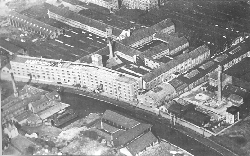These notes were written about 1967 and show how tanning hides to produce leather was a major industry in and around Runcorn in the 19th. and first half of the 20th. centuries. Camden, Puritan, Astmoor,and Highfield were well-known tanneries in the Runcorn area. Their demise after the 1950's was swift and final and all tanning had ceased in Runcorn from 1968. Only some outer walls of the Camden tannery now remain in the car park off High Street, and the last building of the Puritan tannery in Halton Road has now gone. These notes refer to the Highfield tannery, which stood about where Hardwick Road (Astmoor Industrial Estate) and the Daresbury Expressway runs at that point, on the north side of the Bridgewater Canal.

Some notes on "The Highfield Tanning Co., Runcorn"
This picture is of the former Highfield Tannery in Runcorn. The broad black band running from bottom-right to middle-left across the picture is the Bridgewater canal and not a road.
1. The date of this Company in its present form is 1888, but it almost certain that there was a tannery on this site for at least 100 years before that, as it is mentioned in a survey of Runcorn Trades dated 1810 (besides other local evidence).
2. At the time of the founding of the original tannery, there were two or three little yards in every town in England, which existed to use up the local supply of hides and skins. It could not, therefore, be said, that Runcorn was "chosen" at all. This tannery has survived where hundreds of similar small 19th Century Tanyards disappeared. This has probably been helped (apart from special enterprise by the owners) due to its proximity to a major seaport. Present day tanneries import 50% of their hides and 90% of their tanning materials.
3. Proximity to a major seaport is still a great advantage. The majority of sole leather is used in the Midlands and one would imagine that sole leather yards would be there on the spot to supply the demand: this is not so, and there are virtually no sole leather yards in that area. Runcorn is fortunate in being allowed to use some of the Liverpool water supply from North Wales. This is unusually pure and is a great benefit in tanning. Like other tanneries on estuaries, we are able to discharge our effluent without expensive treatment. There is legislation at present in Parliament to correct this unhygienic use of estuaries.
4. We use Ox, Cows and Bull hides, 60% of which are English. The remainder are bought from Western Europe, North and South America and New Zealand.
The tanning materials are also imported. These are :-- Mimosa - South Africa
- Quebracho - South America
- Myrabolans - India
- Sweet Chestnut - France and Italy
- Valonea - Turkey
- Sumac - Cyprus
5. This tannery produces all classes of sole leather from the heaviest for Army boots down to the thinnest for ladies evening shoes. It also produces soles for house shoes. The greater part of the production is thin upholstery leather for motor cars and arm chairs, and thicker leather for suit cases, brief cases, golf bags, men's waist belts, cycle saddles, to name a few. We also make leather suitable for horses harness traces, leather for making up into industrial belting, together with fancy leather for ladies handbags and men's wallets. In the last few years we have also started producing leathers for shoe uppers and clothing. This reflects the changes in the leather trade over the past 10 years, as many tanneries producing only sole leather have closed down and new uses for leather have been stimulated.
6. All the overseas raw materials are imported by shipping. 90% of the English materials by road transport. Outward transport of leather is 80% by road, 19% by rail, 1% by air. Bi-products outward 100% by road. Recently there have been developments at the Runcorn Docks and we are now able to make direct shipments to the Continent from Runcorn. This preference for road transport is due to the fact, that we have no rail siding. As regards Canals, it is true that the Bridgewater Canal is alongside the works, and this was used regularly up to 1951 to bring in coal for our Boilerhouse, but owing to the poor quality of the coal, we decided to change over to oil firing at that date. Fuel oil arrives by tanker.
Recent history of Highfield, 1929-1967
1929-1939| What is "tanning leather? | Return to Home page |